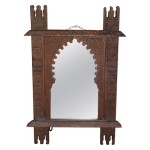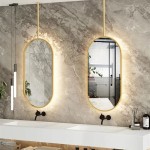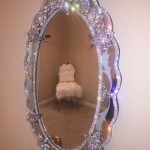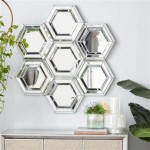Brackets To Hang Heavy Mirror: A Comprehensive Guide
Hanging a heavy mirror requires more than just a nail and a prayer. The weight and fragility of mirrors demand careful planning and the selection of appropriate hardware. Choosing the right brackets is paramount for ensuring the mirror's safety and preventing damage to both the mirror itself and the wall supporting it. This article provides a thorough examination of the factors to consider when choosing brackets to hang heavy mirrors, outlining different bracket types, installation techniques, and safety considerations.
The decision to hang a heavy mirror involves assessing several critical elements. These assessments determine the appropriate bracket style, the necessary weight capacity, and the installation methods needed for a secure and aesthetically pleasing result. Ignoring any of these aspects can lead to disastrous consequences, including the mirror falling, damaging property, and potentially causing injury.
Key Point 1: Factors Influencing Bracket Selection for Heavy Mirrors
Several factors influence the selection of brackets suitable for hanging heavy mirrors. These considerations range from the mirror's physical characteristics to the construction and material of the wall. A meticulous evaluation of these elements will guide the selection process and ensure a stable and secure installation.
Mirror Weight: The most crucial factor is the weight of the mirror. This information is typically available from the manufacturer or can be estimated based on the mirror's dimensions and thickness. It is essential to overestimate slightly to account for any potential variations in material density or manufacturing tolerances.
Mirror Dimensions: While weight is paramount, dimensions also play a role. A wider or taller mirror, even if it's not exceptionally heavy, can exert uneven pressure on the brackets. This can necessitate a bracket system that provides support across a larger surface area or multiple points of contact.
Wall Material: The wall's construction directly impacts the type of anchors and brackets that can be used. Drywall, plaster, wood studs, and concrete each require different fastening techniques. Drywall, being the weakest of these options, generally requires specialized anchors designed to distribute the mirror's weight across a larger area.
Stud Location: Finding and utilizing wall studs is the most secure method for hanging heavy items. Studs provide a solid, load-bearing foundation that can easily handle the weight of most heavy mirrors. If stud locations align with the desired mirror placement, brackets can be directly screwed into the studs, providing maximum stability.
Desired Aesthetics: The brackets should complement the mirror's style and the overall room decor. While functionality is the primary focus, the brackets should not detract from the mirror's aesthetic appeal. Some brackets are designed to be hidden behind the mirror, while others are intentionally decorative and meant to be visible.
Existing Mirror Hardware: Some mirrors may come with pre-installed mounting hardware, such as D-rings or wire. These provisions can influence the type of brackets required, potentially requiring modifications or adaptations to ensure compatibility and secure attachment.
Key Point 2: Types of Brackets Suitable for Heavy Mirrors
A diverse range of brackets is available to accommodate varying mirror sizes, weights, and mounting preferences. Each type offers specific advantages and disadvantages, making careful consideration necessary to select the most appropriate option for a given scenario.
Heavy-Duty Z-Bar Hangers: Z-bar hangers (also known as French cleats) are a popular choice for hanging heavy mirrors. They consist of two interlocking metal strips, one mounted to the wall and the other attached to the back of the mirror. The interlocking design distributes the weight evenly and provides a secure, almost seamless, installation. Z-bars are particularly well-suited for larger, heavier mirrors.
Heavy-Duty D-Ring Hangers: D-rings are metal rings attached to the back of the mirror, typically used in conjunction with picture wire. For heavy mirrors, heavy-duty D-rings and thick picture wire are essential. The wire is then hung on a hook or bracket secured to the wall. While relatively simple, this method requires meticulous attention to ensure the D-rings are securely attached to the mirror and the wall hook is appropriately rated for the mirror's weight.
Mirror Mounting Clips: Mirror mounting clips are small metal or plastic clips that grip the edges of the mirror and hold it in place. They are typically used in sets of four, with two clips at the bottom to support the mirror's weight and two clips at the top to secure it. While suitable for smaller mirrors, heavy-duty mirror mounting clips are available for larger applications. It’s crucial to select clips with adequate weight capacity and ensure they are securely anchored to the wall.
L-Brackets: L-brackets, also known as angle brackets, are a versatile option for supporting heavy mirrors. They are typically made of metal and have two arms that form a right angle. One arm is attached to the wall, and the other supports the mirror from underneath. L-brackets provide a strong and stable support system but may be visible depending on the mirror's design and mounting height.
Heavy-Duty Picture Hooks: While not technically brackets, heavy-duty picture hooks are designed to support significant weight. These hooks are typically made of hardened steel and are designed to be driven directly into the wall. They are suitable for hanging mirrors with D-rings or wire, provided the hook's weight rating exceeds the mirror's weight by a considerable margin. The wall material must be solid enough to hold the hook securely.
Adjustable Mirror Hanging Systems: These systems often involve a track mounted to the wall with adjustable hooks or clamps that can be positioned to accommodate the mirror's size and weight. They offer flexibility in terms of placement and can be particularly useful for hanging multiple mirrors or adjusting the mirror's height over time.
Key Point 3: Installation Techniques and Safety Considerations
Proper installation techniques are crucial for ensuring the safe and secure hanging of a heavy mirror. Ignoring these steps can compromise the integrity of the installation and lead to potentially dangerous situations. Moreover, prioritizing safety during the installation process is paramount to prevent injuries and damage.
Stud Finder Utilization: Prior to any drilling or fastening, use a stud finder to locate wall studs precisely. Mark the stud locations clearly. Whenever possible, anchor the brackets directly into the studs for maximum support. If stud placement does not align with the desired mirror location, use appropriate drywall anchors designed to handle the mirror's weight.
Anchor Selection for Drywall: When studs are not accessible, select heavy-duty drywall anchors rated for the mirror's weight. There are several types of drywall anchors, including toggle bolts, molly bolts, and self-drilling anchors. Toggle bolts generally offer the highest weight capacity and are recommended for very heavy mirrors. Carefully follow the manufacturer's instructions for installing the anchors correctly. Make sure to pre-drill the appropriate size hole for the anchor.
Accurate Measurement and Leveling: Precise measurements are essential for ensuring the mirror is hung straight and level. Use a level to verify the horizontal alignment of the brackets before securing them to the wall. Take accurate measurements to ensure the brackets are positioned correctly to support the mirror's weight evenly.
Secure Bracket Attachment: Use appropriate screws or bolts to attach the brackets to the wall and/or the mirror. Ensure the screws are long enough to penetrate deeply into the stud or drywall anchor but not so long that they protrude through the wall or mirror. Tighten the screws securely but avoid over-tightening, which can damage the wall or strip the screw threads.
Mirror Mounting Hardware Inspection: If the mirror already has mounting hardware installed, thoroughly inspect it for any signs of damage or wear. Replace any damaged or worn hardware with new, heavy-duty components. Ensure the mirror's D-rings, wire, or other mounting hardware are securely attached to the mirror frame before attempting to hang it.
Teamwork and Assistance: Hanging a heavy mirror is often a two-person job. Enlist the help of another person to assist with lifting and positioning the mirror during installation. This will reduce the risk of dropping the mirror or straining yourself.
Safety Gear and Precautions: Wear safety glasses to protect your eyes from debris during drilling and fastening. Use work gloves to improve your grip and protect your hands. Avoid wearing loose clothing or jewelry that could get caught in power tools. Before drilling, check for electrical wires or plumbing behind the wall to avoid potential hazards.
Testing and Verification: Once the mirror is hung, carefully test its stability by gently pushing and pulling on it. Verify that the brackets are securely holding the mirror in place and that there is no excessive movement or wobble. If any instability is detected, immediately address the issue by tightening the screws, adjusting the brackets, or adding additional support.
Preventative Maintenance: Periodically inspect the brackets and mounting hardware to ensure they remain secure and in good condition. Tighten any loose screws or replace any damaged components as needed. This will help prevent the mirror from falling and ensure its long-term stability.
Selecting and installing brackets to hang heavy mirrors requires a systematic approach. Understanding the mirror's characteristics, wall construction, appropriate bracket types, and safe installation techniques are all vital aspects of a successful installation. Taking the time to carefully consider these factors will ensure the mirror is hung safely, securely, and aesthetically improves the space.

How To Hang A Heavy Mirror C R F T

How To Hang A Heavy Mirror

How To Hang A Heavy Mirror

How To Hang A Heavy Mirror With Pictures Wikihow

Heavy Duty Large Picture Mirror Hanging Kit 50kg Hook D Ring Set

How To Hang A Large Or Heavy Mirror

A Better Way To Hang Heavy Mirror Hanging Pictures

Heavy Duty Large Picture Mirror Hanging Kit 50kg Hook D Ring Set

Simple Mount 30 In Heavy Duty Mirror And Picture Hanger Hm 30d The Home Depot

How To Hang A Heavy Mirror Or Picture True Value







